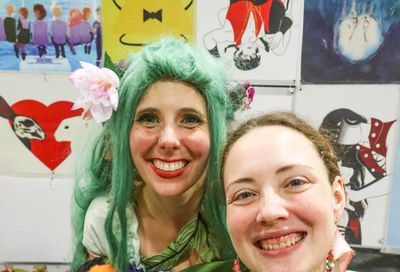First Look: We Happy Few is fun but flawed
We Happy Few offers an intriguing, if imperfect glimpse into a dystopian alternate reality

We Happy Few is both a victim and product of our cynical modern world. Drawing inspiration from countless dystopian sources — 1984, Brazil, Brave New World, BioShock, A Clockwork Orange, and V for Vendetta, to name but a few — it’s set in an alternate reality 1960s, on the island city of Wellington Wells. In this timeline, Britain failed to stop the Nazis invading, but Wellington Wells successfully repelled them thanks to some unspoken, horrific means.
The horrors of those post-war years resulted in dictatorial control of the populace, who forget their atrocities thanks to Joy, a hyper-antidepressant that not only suppresses all negative thoughts, but transforms surroundings from bleak and austere into colorful and beautiful. Joy is a wonder drug, designed to make everything better for everyone. The comparisons with contemporary society — and our addiction to pills as a cure-all for every malady — are numerous.
Perhaps predictably, Joy has a darker side. Anyone found not taking it is labelled a “Downer,” and either forcibly given the drug or ejected from the center of the city to the wastelands on the outskirts of the island. The local constabulary (or “Bobbies”) will enforce Joy with brutal efficiency, but so too will the residents themselves. Stop taking your Joy, and murderous mobs will quickly descend to ensure the status quo is maintained. Talk about side effects.
It’s here I should mention that We Happy Few is not a finished game. It is a preview, an alpha test of a product that’s roughly fifty percent complete. Developer Compulsion Games — known for 2013’s Contrast — has released it in early access in order to gain valuable feedback. A tiny studio, We Happy Few seems an impossibly large task, given its grand aims, beautiful presentation, rich art style and a trailer at this year’s E3 which left many buzzing about “the next BioShock.” However, We Happy Few is not the next BioShock — it was never intended to be. It has always been, and likely will remain, a survival game. It’s here that small development team plus lofty goals meet practical reality: procedurally-generated survival games, where the world is created randomly around you, are relatively low-impact for smaller studios to make. And, for the most part, Compulsion has gotten the basic building blocks right.

Players start the game as Arthur Hastings, a clerk in an office dedicated to censoring old newspapers. Mentions of the war Wellington Wells fought to repel? Heavens no. Stories about old ladies winning vegetable growing contests? Absolutely! After reading an article about his brother, presumed killed, Arthur starts to remember the past. Players are faced with an immediate choice: take Joy to forget, or throw it away and continue to remember (hint: choosing the former is an immediate game over). The darker surface underneath Joy’s glossy sheen becomes immediately apparent: Without the drug, Arthur notices the dilapidated appearance of the office, the stacks of work that are piling up, the missing coworkers who’ve spent too long “on vacation.” At a birthday party for another worker, Arthur is told to hit a pinata — the player smacks it, causing a shower of blood to appear. The unwitting, drug-filled workers start tucking into the innards of what transpires to be a dead rat. The now coherent Arthur retches (understandably) and is labelled a Downer. A short chase ensues, he’s beaten around the head by Bobbies, and that’s it. There will be no more story until the final version of the game lands in 2017, alongside two other playable characters, each with their own backstories and motivations for stopping their Joy intake. For the moment, players only have the basic elements of the game to enjoy — and, at least in their current state, it’s a mixed bag.
First, the most obvious thing about We Happy Few: the art direction. It is gorgeous. Retrofuturistic Wellington Wells, with its Mod-inspired clothing, ’60s architecture and design, classic sci-fi weaponry and security devices, and quaint, Little England feel is a wonderful place to roam around. We Happy Few excels at evoking the atmosphere of this horrible, drug-addled world. Strong lighting effects, unique character designs and numerous small details abound, while audio is pretty rich, including Arthur’s nervous voice and the chattering and yelling of other residents, but especially Uncle Jack, the mysterious television figure piped into homes and streets. It’s also an incredibly creepy place, from the fog piped into certain areas, to the white masks residents wear to enhance how happy they look, to the constant sense that the players are one misstep away from being discovered as a Downer.

Unfortunately, it’s not perfect. Random generation means that too often players will see the same assets repeated, particularly in the starting area of Garden District, where Arthur wakes up after he’s been knocked unconscious. Decrepit, bombed, or burned-down houses start to blend into one another, the same tree appears countless times, the Wastrels — Downers who’ve survived so long in the outskirts that they’ve gone insane — are too repetitive and it’s easy to get lost, as the generation sticks to a grid layout (the very opposite of which you’ll find in most English towns), meaning that every corner looks the same as the last.
However, you won’t have time to think too much about this, as your main goals are to escape Wellington Wells and, above all else, survive. While there’s no story, per se, there is an abundance of lore-building present in this version of the game, as well as notes, journals and newspaper clippings scattered throughout the world. Certain characters and areas will offer quests, which inevitably require finding an item and returning to the original area. This means lots and lots and lots of scavenging. We Happy Few delights in having players comb through every post box, closet, trash can, pile of rubble, and body of someone you’ve just knocked out. There’s a crafting system present, and an almost overwhelming variety of objects can be constructed to help Arthur survive, advance, and fight back against anyone he annoys along the way.
Simultaneously, you’ll also be micro-managing Arthur’s needs, like a dystopian The Sims. However, perhaps Arthur shouldn’t be quite as concerned with escaping Wellington Wells as he should be with the rate at which he gets hungry, thirsty, or tired. These stats deplete far too quickly and in just a couple of hours (in-game, mere minutes in the real world), Arthur can go from perfectly healthy to dying of thirst. Or hunger. Or exhaustion. Or food poisoning, because all he could find to eat was some rotten mushrooms and didn’t have any Nexamide pills to cure his sickness. Or any other concoction of woes that We Happy Few throws at Arthur, such as severe bleeding after too many blows, the plague (caught from really sick Wastrels), or various other maladies. Perhaps it’s a good thing that the game’s default “permadeath” setting can be switched off.

It’s not helped by an interface that borders on the obtuse, in particular the inventory system, where you’ll spend a lot of your time crafting items for Arthur and selecting the food, water and weapons he needs. It’s a hot mess at the moment, with objects not easily distinguishable from one another. Need a bandage in a hurry? Good luck finding it before you succumb to your wounds, or are beaten senseless by another horde — the janky AI, which can strike without notice, or ignore you completely, doesn’t help here.
But there is also a lot that We Happy Few gets right. Once you’ve gotten past the survival hump and made it into the Joy-popping center of town, it becomes a different game, as you’re forced to use caution, stealth, and old-fashioned good manners to convince the locals that you’re as drugged up and carefree as they are. Running is bad, entering houses is bad, not saying hello to old ladies is bad (they’ll start screaming for Bobbies). Wouldn’t it just be easier to take a Joy and not have to worry about fitting in? Sure, there’s the side effects, the withdrawals, and potentially fatal overdoses, but you won’t arouse quite as much suspicion. This is also where the overbearing survival aspects lend an extra hand to storytelling: if you’re dying of thirst, you’ll drink from a tap, and there you’ll find that Joy is in the water supply — Wellington Wells’ residents are being drugged even without their knowledge. It’s one of countless smaller details that add to our understanding of Arthur’s world. I just wish that taking Joy had a greater effect — unlike the rat/pinata intro, popping a pill in the main game just adds a rosy sheen and a rainbow to the sky. The streets don’t glisten and burned out buildings still look burned out. It’s one of numerous areas the game could be improved.
However, as it stands, We Happy Few does exactly what it says on the tin: it offers a preview of the full game. Compulsion has already promised that fixes are on the way for the extreme hunger/thirst/exhaustion depletion, quest markers that don’t update, pathetic durability of some weapons, and more. In the future, there’ll be greater variety in its world generation, more world-building, better quest and compass interfaces to help you navigate, and more varied dialogue from characters.
With a while until the full game is released, there’s a lot to be excited about. Sure, at its core We Happy Few is another survival game, but Compulsion is doing its best to ensure that everything around that is compelling, detailed, and narratively rich. What happened that forced Wellington Wells to develop Joy? Who is Uncle Jack? What happened to those on mainland Britain? These are all questions I can’t wait to find answers to, and with more refined gameplay and less extreme survival elements, We Happy Few could easily become one of the better examples of the survival genre. Is it worth your $30 just now? No. Give it another few updates before you dip your toe in, as too much right now just doesn’t work. Is it something that should be on your radar? Absolutely. Now excuse me. I need to go take my Joy.
We Happy Few is available on PC and Xbox One in early access previews.
Support Metro Weekly’s Journalism
These are challenging times for news organizations. And yet it’s crucial we stay active and provide vital resources and information to both our local readers and the world. So won’t you please take a moment and consider supporting Metro Weekly with a membership? For as little as $5 a month, you can help ensure Metro Weekly magazine and MetroWeekly.com remain free, viable resources as we provide the best, most diverse, culturally-resonant LGBTQ coverage in both the D.C. region and around the world. Memberships come with exclusive perks and discounts, your own personal digital delivery of each week’s magazine (and an archive), access to our Member's Lounge when it launches this fall, and exclusive members-only items like Metro Weekly Membership Mugs and Tote Bags! Check out all our membership levels here and please join us today!























You must be logged in to post a comment.